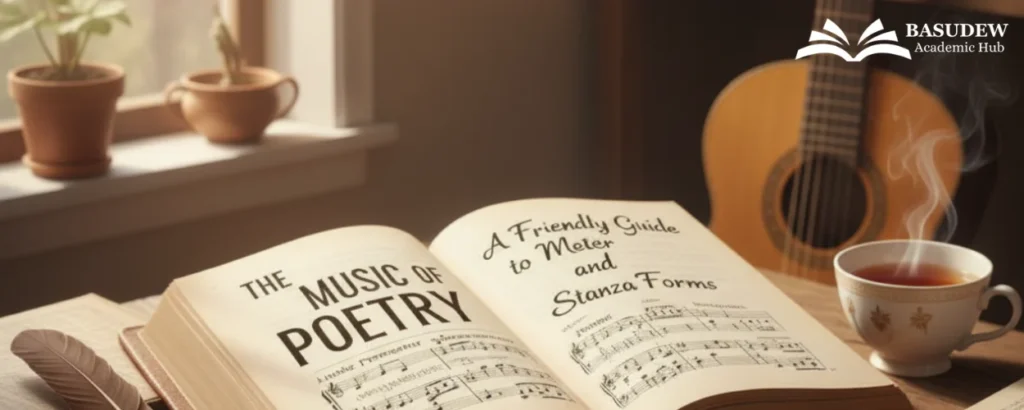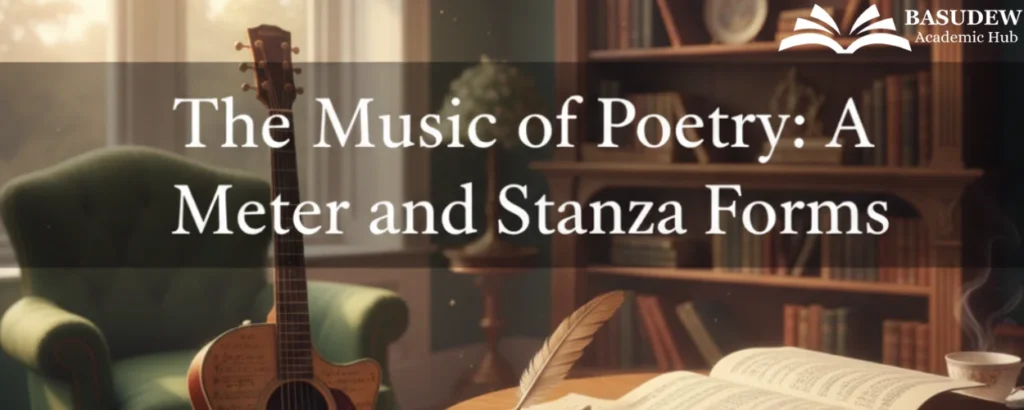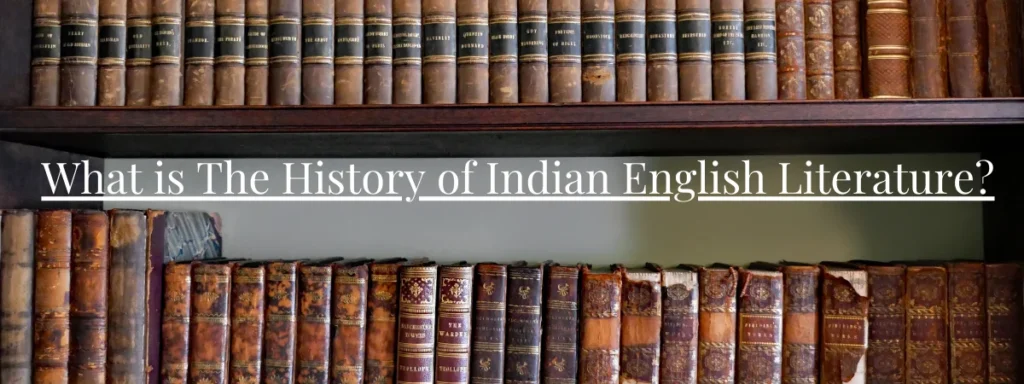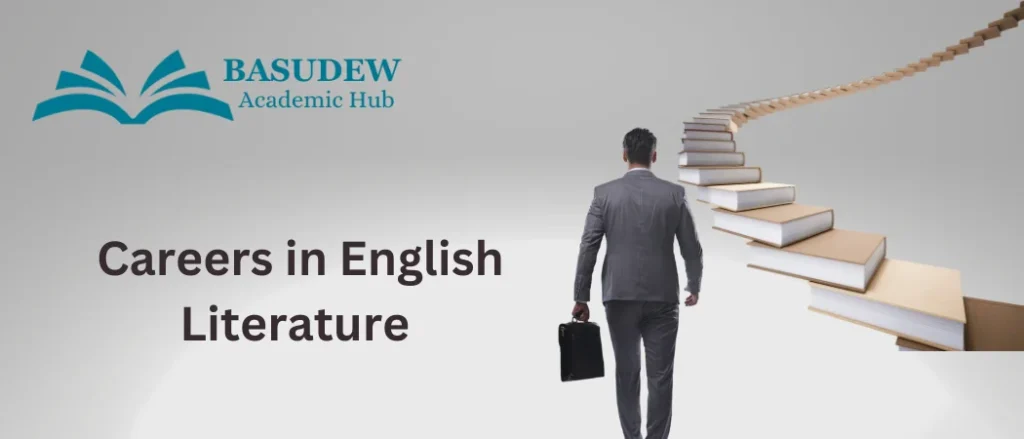Have you ever found yourself tapping your foot to a song, completely unconsciously? Or have you ever gotten a nursery rhyme like “Twinkle, Twinkle, Little Star” stuck in your head? If you have, then you already understand the power of rhythm and pattern. Poetry is just like that. It’s a form of writing that doesn’t just want to tell you a story or share a feeling; it wants to make you feel it in your bones, to hear a kind of music in the words themselves.
The two main ingredients that create this musical effect in poetry are Meter and Stanza Forms. They might sound like complicated terms from a dusty old textbook, but they’re actually simple, powerful tools. Think of it this way: if a poem is a song, then the meter is the beat, and the stanza is the verse. This article is your friendly backstage pass to understanding how this magic works.
In this article, we’ll explore these essential building blocks of poetry in simple, easy-to-understand language. Whether you’re a student just beginning to study poetry, an aspiring poet, or simply someone who loves reading poems, this guide will help you understand how poets create those magical rhythms and structures that make poetry so special.
What is Meter?
Meter is the rhythmic pattern of stressed and unstressed syllables in a line of poetry. Think of it as the heartbeat of a poem – a regular pulse that gives the verse its musical quality. Just as music has beats and measures, poetry has meter.
When we speak naturally, we put emphasis or stress on certain syllables in words. For example, in the word “poetic,” we stress the second syllable: po-ET-ic. In the word “poetry,” we stress the first syllable: PO-e-try. Meter in poetry takes advantage of this natural stress pattern to create rhythm.
Understanding Stressed and Unstressed Syllables
Before we dive deeper into meter, let’s understand what stressed and unstressed syllables mean.
A stressed syllable is one that you emphasize when you say it. It sounds louder, longer, or stronger than the syllables around it. We often mark stressed syllables with this symbol: /
An unstressed syllable is one that you don’t emphasize. It’s softer and shorter. We often mark unstressed syllables with this symbol: ˘
Let’s look at some examples:
- LOVE (one stressed syllable)
- be-LOW (unstressed, then stressed)
- HAP-pi-ness (stressed, unstressed, unstressed)
- un-der-STAND (unstressed, unstressed, stressed)
Basic Units of Meter: Feet
In poetry, we organize stressed and unstressed syllables into units called feet. A foot is a combination of stressed and unstressed syllables that repeats to create a pattern. Think of a foot as one musical measure in the rhythm of the poem.
There are several common types of feet in English poetry:
1. Iamb (Iambic)
An iamb consists of one unstressed syllable followed by one stressed syllable: ˘ /
Example: be-LIEVE, a-LONE, the SUN
This is the most common foot in English poetry because it closely mimics natural English speech patterns.
Example line: “Shall I com-PARE thee TO a SUM-mer’s DAY?”
2. Trochee (Trochaic)
A trochee is the opposite of an iamb. It consists of one stressed syllable followed by one unstressed syllable: / ˘
Example: HAP-py, NE-ver, SUN-shine
Example line: “TY-ger, TY-ger, BURN-ing BRIGHT”
3. Anapest (Anapestic)
An anapest consists of two unstressed syllables followed by one stressed syllable: ˘ ˘ /
Example: in-ter-VENE, un-der-STAND, in a RUSH
Example line: “Twas the NIGHT before CHRIST-mas and ALL through the HOUSE”
4. Dactyl (Dactylic)
A dactyl is the opposite of an anapest. It consists of one stressed syllable followed by two unstressed syllables: / ˘ ˘
Example: MER-ri-ly, BEAU-ti-ful, TEN-der-ly
Example line: “THIS is the FOR-est pri-ME-val, the MUR-mur-ing PINES”
5. Spondee (Spondaic)
A spondee consists of two consecutive stressed syllables: / /
Example: HEARTBREAK, MOONLIGHT, STOP NOW
Spondees are rarely used for entire lines but often appear within other metrical patterns for emphasis.
6. Pyrrhic
A pyrrhic foot consists of two unstressed syllables: ˘ ˘
Example: in the, of a
Like spondees, pyrrhic feet are rarely used alone but appear within other patterns.
Measuring Lines: Metrical Names
Once we know what type of foot is being used, we also need to count how many feet appear in each line. The number of feet in a line determines its length. Here are the common terms:
- Monometer: one foot per line
- Dimeter: two feet per line
- Trimeter: three feet per line
- Tetrameter: four feet per line
- Pentameter: five feet per line
- Hexameter: six feet per line
- Heptameter: seven feet per line
- Octameter: eight feet per line
When we describe a poem’s meter, we combine the type of foot with the number of feet per line. For example:
Iambic pentameter = five iambs per line (the most famous meter in English poetry) Trochaic tetrameter = four trochees per line Anapestic trimeter = three anapests per line

Famous Examples of Meter
Iambic Pentameter
This is by far the most common meter in English poetry. It consists of five iambs per line, creating a ten-syllable line with the stress pattern: ˘ / ˘ / ˘ / ˘ / ˘ /
Shakespeare used iambic pentameter extensively. Here’s a famous example from “Hamlet”:
“To BE or NOT to BE, that IS the QUES-tion”
And from his Sonnet 18:
“Shall I com-PARE thee TO a SUM-mer’s DAY? Thou ART more LOVE-ly AND more TEM-per-ATE”
Trochaic Tetrameter
This meter uses four trochees per line, creating an eight-syllable line with the stress pattern: / ˘ / ˘ / ˘ / ˘
William Blake’s “The Tyger” is written in trochaic tetrameter:
“TY-ger, TY-ger, BURN-ing BRIGHT IN the FOR-ests OF the NIGHT”
Anapestic Tetrameter
This meter uses four anapests per line, creating a twelve-syllable line with the stress pattern: ˘ ˘ / ˘ ˘ / ˘ ˘ / ˘ ˘ /
Lord Byron used this meter effectively in “The Destruction of Sennacherib”:
“The As-SYR-ian came DOWN like a WOLF on the FOLD”
Why Does Meter Matter?
You might wonder why poets bother with all these rules about stressed and unstressed syllables. The answer is that meter serves several important purposes:
1. Creates Musicality
Meter gives poetry its musical quality. The regular rhythm makes poems pleasant to hear and easy to remember. This is why children’s nursery rhymes and songs use strong, regular meters.
2. Emphasizes Meaning
The stressed syllables naturally draw attention to important words. Poets can use this to emphasize key ideas or emotions in their work.
3. Creates Expectations
Once a meter is established, readers anticipate its continuation. When a poet breaks the pattern, it creates a powerful effect, drawing attention to that particular moment in the poem.
4. Aids Memory
Regular meter makes poems easier to memorize. This was especially important in oral traditions before widespread literacy, when poems and stories were passed down through recitation.
5. Expresses Emotion
Different meters create different moods. Iambic meter often sounds natural and conversational. Trochaic meter can sound forceful or dramatic. Anapestic meter creates a galloping, energetic feel. Dactylic meter can sound grand and sweeping.
What are Stanzas?
Now that we understand meter, let’s explore stanza forms. A stanza is a grouped set of lines in a poem, separated from other stanzas by a blank line. Think of stanzas as the paragraphs of poetry. Just as paragraphs organize prose writing into manageable sections, stanzas organize poetry.
Stanzas serve several purposes:
- They organize thoughts and ideas into distinct sections
- They create visual patterns on the page
- They can create rhythmic patterns through repetition
- They give readers natural pauses for reflection
Stanzas can be any length, but many traditional stanza forms have specific numbers of lines and often follow particular rhyme schemes.
Common Stanza Forms
The Couplet
A couplet consists of two lines that usually rhyme. Couplets are the simplest stanza form. They often express a complete thought in just two lines, making them perfect for pithy statements or conclusions.
Example from Alexander Pope’s “An Essay on Criticism”:
“True ease in writing comes from art, not chance, As those move easiest who have learned to dance.”
Couplets can stand alone or be grouped together to form longer poems. When used at the end of a Shakespearean sonnet, they’re called “closing couplets” and often provide a conclusion or twist to the poem’s argument.
Heroic couplets are a specific type written in iambic pentameter. They were extremely popular in English poetry during the 17th and 18th centuries.
The Tercet (or Triplet)
A tercet is a three-line stanza. Tercets can follow various rhyme schemes, such as AAA (all three lines rhyme), ABA (the first and third lines rhyme), or AAB.
Example from Robert Frost’s “Acquainted with the Night”:
“I have been one acquainted with the night. I have walked out in rain—and back in rain. I have outwalked the furthest city light.”
The terza rima is a famous form using tercets. It uses an interlocking rhyme scheme: ABA BCB CDC, and so on. Dante used this form for his masterpiece, “The Divine Comedy.”
The Quatrain
The quatrain is a four-line stanza and is perhaps the most common stanza form in English poetry. Quatrains are versatile and can follow many different rhyme schemes:
- AABB: two couplets (also called “closed couplets”)
- ABAB: alternating rhyme
- ABBA: enclosed rhyme
- ABCB: only the second and fourth lines rhyme
Example of ABAB rhyme scheme from William Wordsworth’s “I Wandered Lonely as a Cloud”:
“I wandered lonely as a cloud (A) That floats on high o’er vales and hills, (B) When all at once I saw a crowd, (A) A host, of golden daffodils; (B)”
The quatrain’s balance makes it perfect for developing ideas systematically while maintaining a clear structure.
The Quintain (or Quintet)
A quintain is a five-line stanza. While less common than quatrains, quintains appear in various forms throughout poetry. The rhyme scheme can vary widely.
One famous example is the limerick, a humorous five-line form with the rhyme scheme AABBA, typically in anapestic meter:
“There was an Old Man with a beard, (A) Who said, ‘It is just as I feared! (A) Two Owls and a Hen, (B) Four Larks and a Wren, (B) Have all built their nests in my beard!’ (A)”
The Sestet
A sestet is a six-line stanza. Sestets appear frequently in sonnets, where they form the concluding section of a Petrarchan sonnet. They can follow various rhyme schemes, including ABABCC, AABBCC, or AAABBB.
Example from Elizabeth Barrett Browning:
“Go from me. Yet I feel that I shall stand (A) Henceforward in thy shadow. Nevermore (B) Alone upon the threshold of my door (B) Of individual life, I shall command (A) The uses of my soul, nor lift my hand (A) Serenely in the sunshine as before. (B)”
The Septet (or Heptastich)
A septet is a seven-line stanza. The most famous form using seven lines is rhyme royal, which follows the rhyme scheme ABABBCC and was popularized by Geoffrey Chaucer. It’s written in iambic pentameter.
The Octave (or Octet)
An octave is an eight-line stanza. The most famous example is the first eight lines of a Petrarchan sonnet, which typically follows the rhyme scheme ABBAABBA.
Another important eight-line form is ottava rima, which follows the rhyme scheme ABABABCC and is written in iambic pentameter. Lord Byron used this form extensively.
Complex Stanza Forms and Poetic Structures
Beyond basic stanzas, poetry includes many elaborate forms with specific rules about meter, rhyme, and structure. Here are some of the most important:
The Sonnet
The sonnet is one of the most famous and enduring poetic forms. A sonnet consists of fourteen lines, typically written in iambic pentameter. There are two main types:
Petrarchan (Italian) Sonnet: Divided into an octave (eight lines) with the rhyme scheme ABBAABBA, followed by a sestet (six lines) with various possible rhyme schemes (CDECDE, CDCDCD, etc.). The octave typically presents a problem or question, while the sestet provides resolution or answer. This is called the “turn” or “volta.”
Shakespearean (English) Sonnet: Divided into three quatrains and a closing couplet, with the rhyme scheme ABABCDCDEFEFGG. Each quatrain develops a different aspect of the theme, and the couplet provides a conclusion or twist.
Example of a Shakespearean sonnet structure (Shakespeare’s Sonnet 18):
“Shall I compare thee to a summer’s day? (A) Thou art more lovely and more temperate: (B) Rough winds do shake the darling buds of May, (A) And summer’s lease hath all too short a date: (B)
Sometime too hot the eye of heaven shines, (C) And often is his gold complexion dimmed; (D) And every fair from fair sometime declines, (C) By chance or nature’s changing course untrimmed; (D)
But thy eternal summer shall not fade (E) Nor lose possession of that fair thou owest; (F) Nor shall Death brag thou wander’st in his shade, (E) When in eternal lines to time thou growest: (F)
So long as men can breathe or eyes can see, (G) So long lives this and this gives life to thee. (G)”
The Villanelle
The villanelle is a highly structured nineteen-line form consisting of five tercets followed by a quatrain. It uses only two rhymes throughout and repeats two lines alternately as refrains. The rhyme scheme is ABA ABA ABA ABA ABA ABAA.
The most famous villanelle is Dylan Thomas’s “Do Not Go Gentle into That Good Night.” This form’s repetition creates an obsessive, haunting quality perfect for exploring recurring themes.
The Ballad
The ballad is a narrative poem that tells a story. Traditional ballads are written in quatrains called ballad stanzas with alternating four-stress and three-stress lines, typically following the rhyme scheme ABCB (only the second and fourth lines rhyme).
Ballad meter (alternating iambic tetrameter and iambic trimeter) gives ballads their memorable, song-like quality. Many folk songs and traditional stories were preserved as ballads before being written down.
The Ode
An ode is a serious, elevated poem typically addressed to a particular subject. Odes don’t follow a single fixed form, but they’re usually written in stanzas and often use elaborate language and imagery.
The Pindaric ode follows a complex pattern of strophe, antistrophe, and epode. The Horatian ode uses repeated stanzas of the same structure. John Keats’s famous odes, like “Ode to a Nightingale” and “Ode on a Grecian Urn,” use a modified form with ten-line stanzas.
The Haiku
Though not Western in origin, the haiku has become popular in English poetry. This Japanese form consists of three lines with a 5-7-5 syllable pattern (though English-language haiku sometimes vary this). Haiku traditionally capture a moment in nature and include a seasonal reference.
Example from Matsuo Bashō (translated):
“An old silent pond… A frog jumps into the pond, splash! Silence again.”
The Limerick
We mentioned limericks earlier, but they deserve more attention as a popular form. Limericks are five-line poems with an AABBA rhyme scheme, typically in anapestic meter. They’re almost always humorous or nonsensical, making them popular for children’s poetry and comic verse.
The Spenserian Stanza
Named after Edmund Spenser, who invented it for “The Faerie Queene,” the Spenserian stanza consists of nine lines. The first eight lines are in iambic pentameter, and the ninth line is in iambic hexameter (an alexandrine). The rhyme scheme is ABABBCBCC.
This elaborate stanza form was later adopted by Romantic poets like Byron and Keats.
Free Verse: Poetry Without Fixed Meter or Stanza Forms
While we’ve spent considerable time discussing traditional meter and stanza forms, it’s important to mention free verse. Free verse poetry doesn’t follow regular metrical patterns or fixed stanza forms. Instead, it uses natural speech rhythms and breaks lines based on meaning, breath, or other considerations.
Free verse doesn’t mean “no rules” or “anything goes.” Skilled free verse poets carefully craft their line breaks, use sound patterns like alliteration and assonance, and create rhythm through other means. Poets like Walt Whitman, T.S. Eliot, and contemporary poets have proven that powerful poetry can exist without traditional meter.
However, understanding traditional meter and stanza forms helps poets and readers appreciate the craft behind free verse. Even poets who write primarily in free verse benefit from understanding how meter works, as they can then consciously choose when to use or avoid traditional rhythms.
How to Scan a Poem (Finding the Meter)
Scansion is the process of analyzing a poem’s meter. Here’s how to scan a poem:
- Read the poem aloud naturally: Don’t force a rhythm; just speak it as you would normal speech.
- Mark the stressed syllables: As you read, notice which syllables you naturally emphasize. Mark these with a / symbol.
- Mark the unstressed syllables: Mark the softer syllables with a ˘ symbol.
- Identify the pattern: Look for repeating patterns of stressed and unstressed syllables. This tells you what type of foot is being used.
- Count the feet: Count how many feet appear in each line to determine the line length (pentameter, tetrameter, etc.).
- Note variations: Most poems vary from perfect meter occasionally. Poets intentionally vary meter for emphasis or to avoid monotony.
Why Poets Vary from Perfect Meter
While we’ve discussed meter as if it’s always perfectly regular, most good poetry includes variations from the basic pattern. Perfect meter throughout an entire poem would sound mechanical and boring, like a metronome. Poets vary meter to:
- Create emphasis: Changing the expected stress pattern draws attention to particular words
- Reflect meaning: Irregular meter can mirror disruption, chaos, or strong emotion in the poem’s content
- Avoid monotony: Slight variations keep the rhythm interesting
- Mimic natural speech: Perfect meter doesn’t sound like natural speaking
Shakespeare often varied iambic pentameter by starting a line with a trochee (stressed-unstressed instead of unstressed-stressed) or by adding an extra unstressed syllable at the end of a line.
Choosing the Right Meter and Stanza Form
For poets, choosing the right meter and stanza form depends on several factors:
Subject Matter
Serious, elevated subjects might call for forms like the sonnet or ode. Narrative poems work well in ballad form. Humorous or light subjects might use limericks or anapestic meter.
Tone and Mood
The meter itself contributes to mood. Iambic meter sounds natural and conversational. Anapestic meter creates energy and movement. Trochaic meter can sound forceful or solemn.
Length and Complexity
Longer poems might use couplets or quatrains for clarity. Complex philosophical arguments might suit the sonnet form, which provides space to develop and resolve an idea.
Tradition and Innovation
Some poets work within traditional forms to connect with poetic heritage. Others deliberately break or modify traditional forms to create new effects.
Reading Poetry with Meter and Form in Mind
Understanding meter and stanza forms enhances poetry appreciation. When reading poetry:
- Notice the visual structure: How is the poem arranged on the page? Are stanzas regular or varied?
- Read aloud: Poetry is meant to be heard. Reading aloud helps you feel the rhythm and understand how meter affects meaning.
- Listen for patterns: Notice repeated sounds, rhythms, and structures.
- Consider how form serves content: Why did the poet choose this particular form? How does the structure reinforce the poem’s meaning?
- Appreciate the craft: Recognize the skill involved in working within formal constraints while still expressing unique ideas and emotions.
Conclusion
Meter and stanza forms are the architectural elements of poetry. Like a skilled architect who understands how materials and structures work together to create a building, a skilled poet understands how meter and stanza forms work together to create a poem.
Meter provides the musical rhythm through patterns of stressed and unstressed syllables. Whether it’s the natural flow of iambic pentameter, the forceful march of trochaic tetrameter, or the galloping energy of anapestic meter, each metrical pattern creates its own unique sound and feeling.
Stanza forms provide structure and organization. From simple couplets to complex sonnets, each form offers different possibilities for developing ideas, creating emphasis, and engaging readers. The constraints of form, rather than limiting creativity, often inspire it—poets have created magnificent works within the strict rules of forms like the sonnet and villanelle.
While contemporary poetry includes much free verse that doesn’t follow traditional meter and forms, understanding these foundations remains valuable. They represent centuries of poetic tradition and experimentation. They show us how human beings have found countless ways to make language sing, to make words memorable, and to communicate ideas and emotions with precision and beauty.
Whether you’re reading poetry for pleasure, studying it for school, or writing your own poems, understanding meter and stanza forms opens up new dimensions of appreciation and possibility. Poetry is not just what is said, but how it’s said—and meter and stanza forms are essential parts of that “how.”
The next time you read a poem, take a moment to notice its form. Listen to its rhythm. Consider how the poet has used these tools to create something that speaks to the heart while delighting the ear. That’s the magic of meter and stanza forms—they transform ordinary words into extraordinary poetry.





